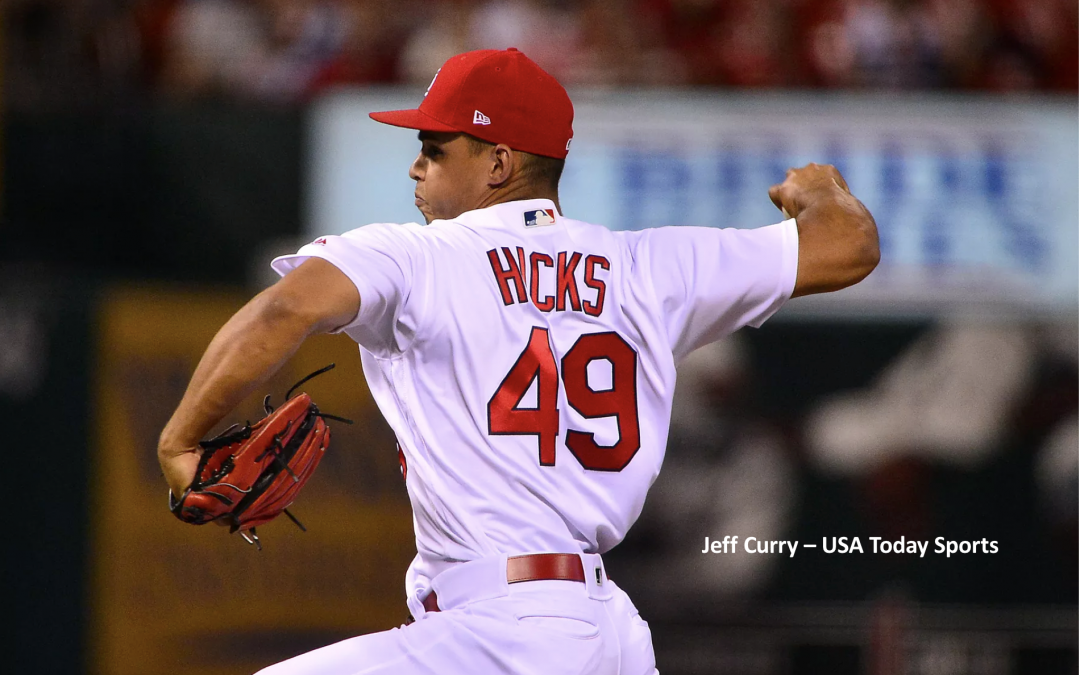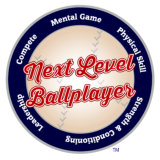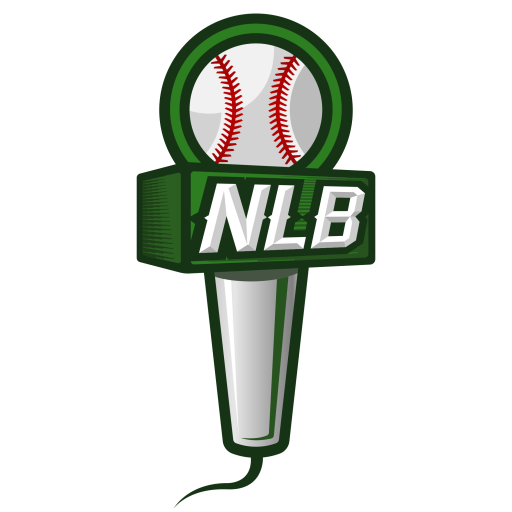I am sure you are already aware that Jordan Hicks is capable of throwing a baseball very hard. Last Sunday he entered a game against the Philadelphia Phillies, and in the process of closing out a 5-1 Cardinals victory, Hicks threw the 5 fastest pitches of the 2018 season per Statcast. His first pitch of the at-bat, a sinker, registered at 104.2 mph, and judging by Herrera’s reaction to the stadium radar gun (located in left field for those of you not familiar with Busch Stadium III), this was the fastest pitch he’s ever witnessed as well.
Hicks has now overthrown the King of fastball velocity in the major leagues: Yankees closer Aroldis Chapman. Since has debut in 2010, Chapman has owned the fastest pitch in the league, and it wasn’t even close.
Before getting into what makes Hicks so unique, here’s a little backstory on the Cardinals’ flamethrower. Drafted out of Cypress Creek High School in the 3rd round of the 2015 Draft, Hicks bypassed a college scholarship to Tulane to pursue professional baseball. Upon signing Hicks, the Cardinals sent the young flamethrower to Johnson City to pitch in the Rookie Appalachian League. Hicks threw 30 solid innings before getting called up to the State College Spikes in the New York Penn league, where he finished out the season with a 1.76 ERA over 30 more innings.
Hicks started the 2017 season at Class A Peoria where he pitched for most of the summer before being promoted to High A Palm Beach. Hicks showed no signs of slowing down in his second full year of professional baseball, going 8-3 with a 2.73 ERA across both levels. If Hicks were following a typical path of a pitching prospect, you would have expected him to start this season in AA playing for the Springfield Cardinals. The Majors seemed even farther away for Hicks earlier in the spring after he was sent to Minor League Camp for disciplinary issues in Spring Training.
The Cardinals shocked the baseball world before Opening Day when they announced Hicks would be on the roster. Having a prospect skip both AA and AAA to pitch out of the bullpen was a risky move by the Cards’ Front Office, but to this point it surely has paid off. Hicks has been the primary bridge to closer Bud Norris this season, sporting a 1.96 ERA in 23 innings all while pitching in important situations- Hicks has the second highest leverage index for the Cardinals so far this season. Hicks has continued to rely upon what got him to the show in the first place: a sinking fastball that hardly ever slips below triple digits. Of all pitchers with at least 20 IP, Hicks’ fastball usage is 11th at 77.7%.
I’m sure some of you may be thinking, a guy that throws 105mph must be impossible to hit, right? Think again, below is a plot of K-BB% vs. fastball velocity for the 10 hardest throwers in the MLB today, the red dot in the graph is Jordan Hicks:
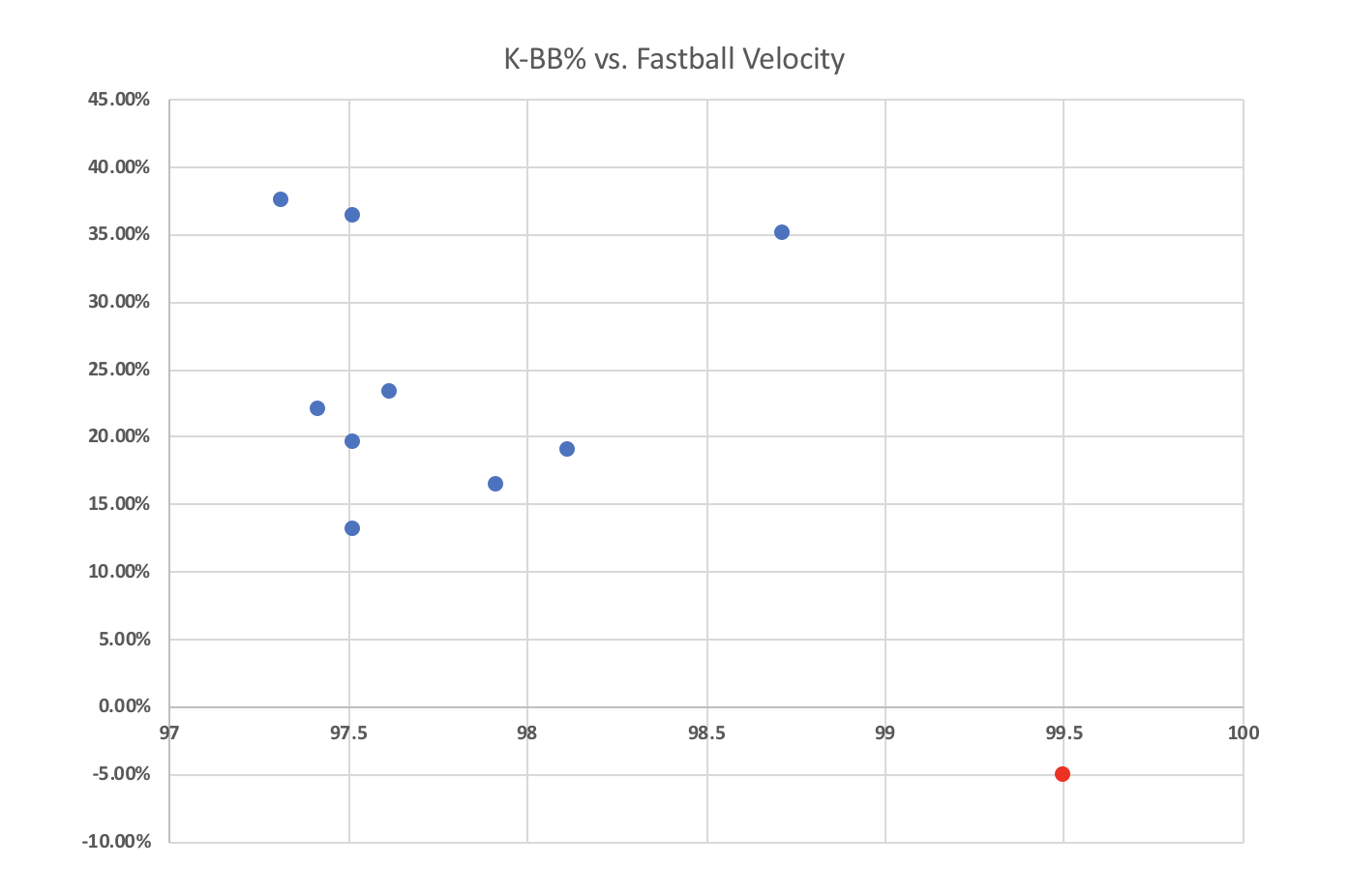
Here is the same graph in table form, with the ten hardest throwing pitchers in baseball sorted by their K-BB%:
| Name | FBv | K% | BB% | K-BB% |
| Edwin Diaz | 97.3 | 47.40% | 9.50% | 37.90% |
| Dellin Betances | 97.5 | 43.70% | 6.90% | 36.80% |
| Aroldis Chapman | 98.7 | 47.40% | 11.80% | 35.50% |
| Luis Severino | 97.6 | 30.00% | 6.30% | 23.70% |
| Noah Syndergaard | 97.4 | 27.80% | 5.30% | 22.50% |
| Joe Kelly | 97.5 | 29.40% | 9.40% | 20.00% |
| Tayron Guerrero | 98.1 | 31.60% | 12.20% | 19.40% |
| Jose Alvarado | 97.9 | 27.70% | 10.80% | 16.90% |
| Arodys Vizcaino | 97.5 | 24.70% | 11.20% | 13.50% |
| Jordan Hicks | 99.5 | 11.20% | 16.30% | -5.10% |
There’s Hicks, the hardest throwing pitcher in baseball, in possession of a negative K-BB%. Out of all major league pitchers with at least 20IP, Hicks ranks 2nd to last in K-BB%, one of 6 pitchers overall in the negative, sandwiched between Bryan Mitchell and Lucas Giolito. That’s not very good company. Not only does Hicks have subpar walk and strikeout rates, he also has underperformed this season by fWAR: his -0.2 mark is tied for 8th worst in the majors out of relievers (min 20IP).
Earlier in the post, I told you we were going to talk about how Hicks is unique, not how he ranks at the bottom of the league in some statistics. Despite all of these subpar peripherals, he has been the best reliever by rWAR (0.5) on a team with a very high chance of making the playoffs. Another way he is so unique: he’s a 21-year-old kid sinking 105 mph in the show.
I don’t think Jordan Hicks is always going to have a higher walk rate than his strikeout rate, and I think over time he will continue to miss more bats. This post is about all of us dreaming on a player that is capable of throwing a baseball 105 without any command or plus secondary offerings. When Hicks does refine his command and secondary pitches, watch out…
A big reason why Hicks doesn’t miss a ton of bats is due to the fact that he throws a sinking fastball, which tend to not generate as many swing and misses as a high-spin four-seamer. On top of that, Hicks’ slider is still a work in progress. There are two main problems I see with the pitch: it’s too slow and has too much horizontal movement. Nine of the ten hardest throwers in baseball throw sliders, and their velocities and horizontal movement are listed below:
| Player | Average Slider Velocity | Average Slider H-Movement |
| Noah Syndergaard | 92.5 | 1.6 |
| Edwin Diaz | 89.0 | 1.3 |
| Luis Severino | 87.8 | 6.3 |
| Joe Kelly | 87.5 | 3.5 |
| Dellin Betances | 87.1 | 5.9 |
| Aroldis Chapman | 85.8 | -5.9 |
| Tayron Guerrero | 85.3 | 2.6 |
| Arodys Vizcaino | 85.3 | 1.0 |
| Jordan Hicks | 84.4 | 8.5 |
Jordan Hicks has the highest fastball velocity of the group and the slowest slider velocity. Hicks is currently throwing a slow, sweeping slider, rather than a tight, sharp breaking ball. Having a 16-18 mph gap between your slider and your fastball almost surely makes the pitch less effective at the big-league level. As Hicks can learn to throw the pitch harder, it may take some of the “sweeping” action out of the pitch making it more of a swing and miss weapon. Harder and tighter sliders miss bats, cc: Noah Syndergaard.
It seems as though Hicks has already been tinkering with the pitch, trying to find the right velocity for it:
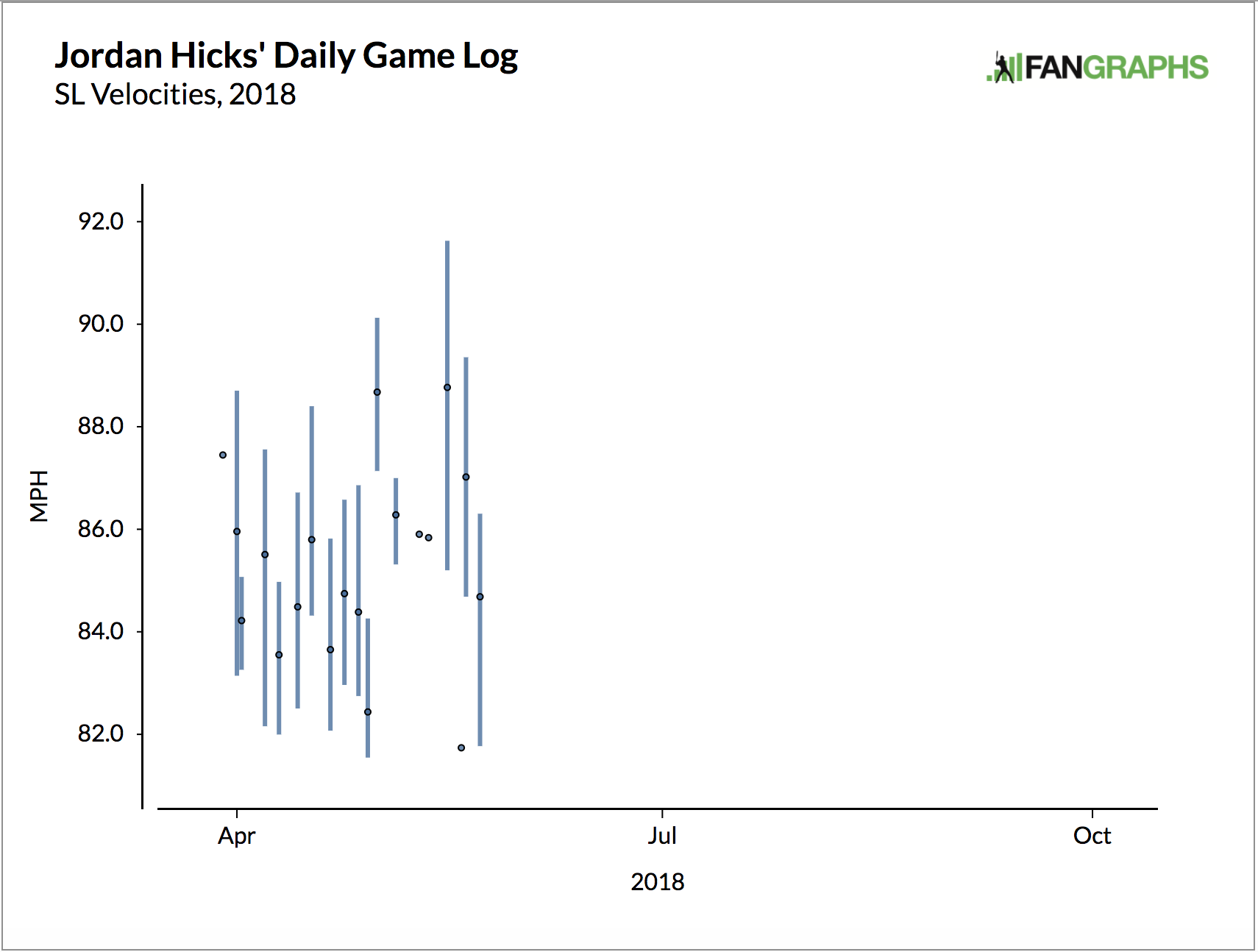
I wanted to see if there was more behind this than just the numbers, so I headed to Baseball Savant and checked out pitcher release points of some of the best pitchers in our group above. If a pitcher has a lower velocity slider with more of a sweeping action, it may indicate he is getting more on top of his fastball and getting around his slider or throwing it at a slightly lower release point. Sure enough, as you can see in the images below, Hicks is doing just that relative to some of his peers:

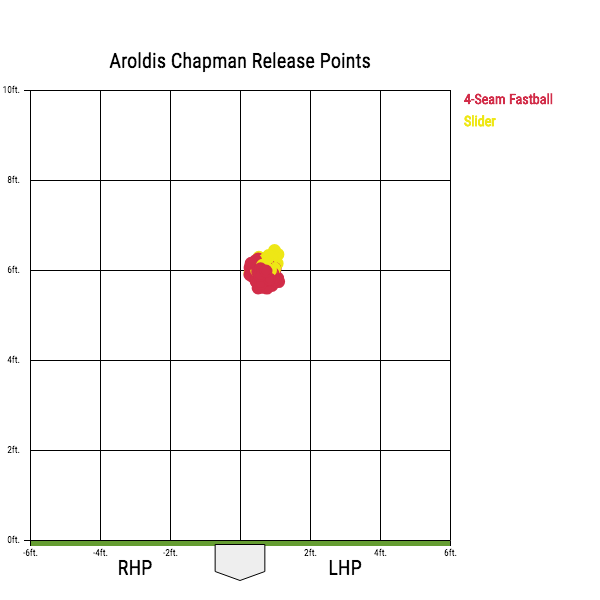
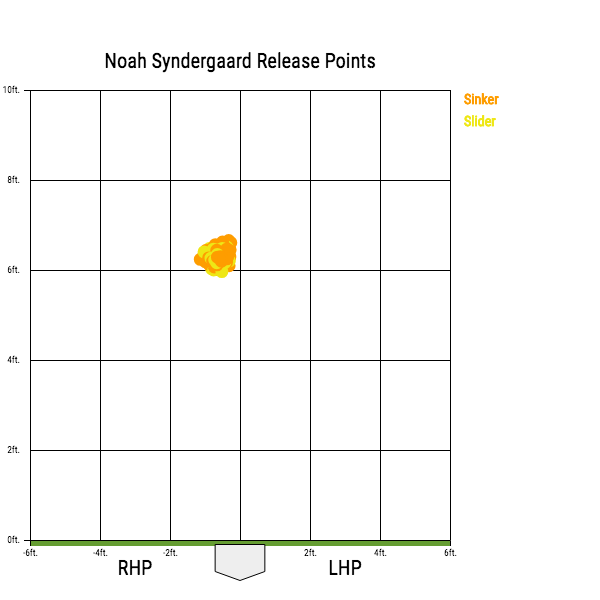

Hicks could certainly benefit from raising his release point on the slider a bit. Not only is the difference in release point easier to pick up on for major league hitters, Hicks is throwing the pitch in more of a “get me over” fashion rather than a strikeout pitch:

Compare that with Noah Syndergaard’s slider location this year:
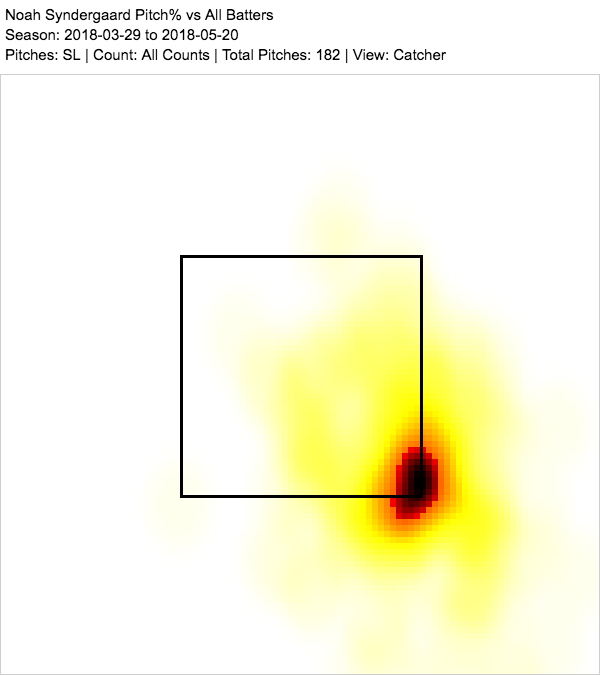
With more consistency and more reps, Hicks will figure out an ideal release point for his breaking ball. It would be beneficial for him to raise it a bit so that it more closely mirrors his fastball and gives him a little bit more bite to the pitch. If he is able to accomplish this, his strikeout numbers may climb steadily.
Hicks has been perfectly useful in his role so far for the Cardinals. He is the type of pitcher that will continue to outperform the advanced metrics based on the fact that he won’t be going through a major league order more than once and he possesses a 61.2 GB%. Only having a few swings at 100+ mph sinkers is much different than having multiple at-bats over the course of a game. There is an argument to be made on relying too much on a metric like FIP for relievers with abnormally high groundball rates when we try and predict their future, but that’s for a different post at a different time.
The Cardinals have to be pleased with what they are getting from Hicks so far. His presence in the pen may play a role in the Cardinals using top prospect Alex Reyes in the starting rotation next week, now that they don’t need as much help in the pen. Hicks will continue to be one of the more interesting pitchers in the game today, and as he matures and develops his advanced statistics will more closely reflect the type of talent he truly possesses. If that’s not one of the more frightening things for hitters in the NL, I don’t know what is.

